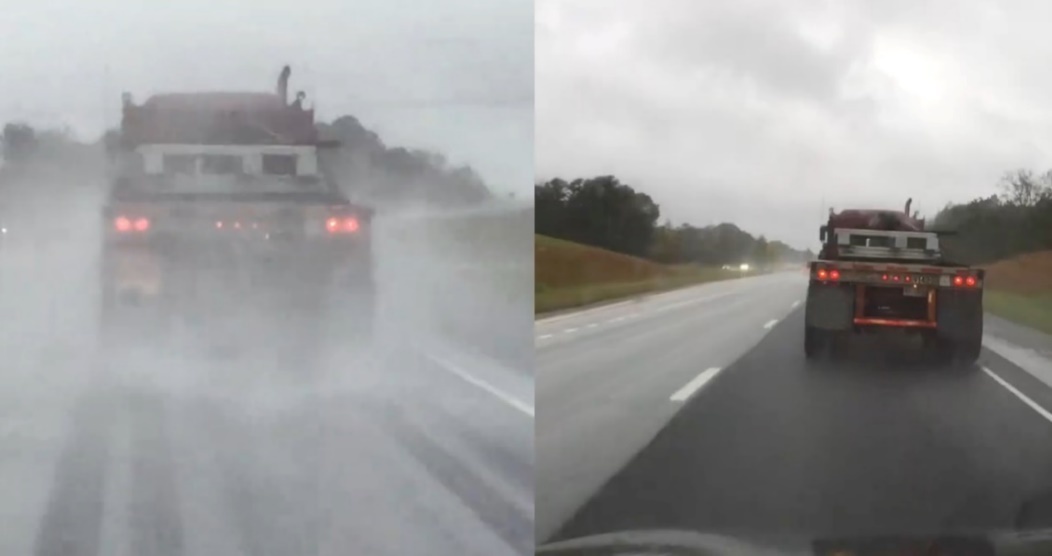TOPS News:
January 2023 |
|
 |
New Research and Technology Help Open-Graded Friction Course Make a Comeback
Open-graded friction course (OGFC), a thin asphalt overlay, is gaining popularity as transportation agencies find ways to improve durability and maintenance while still achieving safety benefits. OGFC improves drainage and tire pavement contact, which decreases hydroplaning. It also reduces noise, stormwater pollutants, and splash and spray to improve visibility. With approximately 85 percent coarse aggregates and high air voids, OGFC can be used as a surface lift or porous pavement system.
 Before and after pictures show how OGFC reduces splash and spray and improves visibility.
Source: National Center for Asphalt Technology.
OGFC use in the U.S. began in the 1970s, but a National Center for Asphalt Technology survey found that by 1998, 38 percent of respondents had discontinued its use due to two main concerns. Since OGFC is permeable, it allows air to circulate through the mix, making it more susceptible to icing during winter. Also, the asphalt binder could prematurely oxidize, causing raveling.
South Carolina receives nearly 50 inches of rain annually. That’s why South Carolina Department of Transportation (SCDOT) Asphalt Materials Manager Cliff Selkinghaus has used OGFC for years to help reduce hydroplaning on high-volume routes. When SCDOT realized it was getting about half the life expectancy out of its OGFC projects, the agency worked with Clemson University to identify ways to improve OGFC design, performance, construction, and maintenance.
The research led to several key recommendations. SCDOT now adds fines to its OGFC mixture, uses a 265-degree warm mix OGFC, and ensures that compaction is completed in less than 15 minutes to prevent excessive cooling. Selkinghaus says e-Ticketing has made a big difference. “We’re able to track trucks and slow the pavers down to five feet per minute if we have to just to keep them moving,” said Selkinghaus.
Selkinghaus shares more OGFC lessons learned in an FHWA webinar. Details can also be found in FHWA-SC-12-04 Evaluation of Open-Graded Friction Courses: Construction, Maintenance, and Performance.
2012 Opened-Graded Friction Course Users
 According to a 2012 survey, more than 60 percent of respondents use OGFC. Source: Report No. FHWA-SC-12-04 “Evaluation of Open-Graded Friction Courses: Construction, Maintenance, and Performance.”
FHWA Offers TOPS Workshops in 2023
The FHWA is offering workshops for both asphalt and concrete TOPS products to State Highway Agencies starting March 2023. The one-day in-person workshops will cover project selection, specifications and acceptance, mixture design and laboratory testing, construction, and deployment strategies for TOPS overlays of interest to the agency. To schedule a workshop, please reach out to Tim Aschenbrener (asphalt) or Robert Conway (concrete).
TOPS Resources
Looking for more information? Visit the FHWA Targeted Overlay Pavement Solutions (TOPS) website for a variety of resources including case studies, one-pagers, and webinars. Contact TOPS co-team lead Tim Aschenbrener (asphalt) or Robert Conway (concrete).
Check out a TOPS Webinar
The TOPS team has hosted four webinars in recent months including:
Concrete over Concrete Unbonded Overlays
Learn about the latest COC-U advancements, benefits, specifications, and construction considerations.
Stone Matrix Asphalt and Highly Modified Asphalt Webinar
Learn about SMA and HiMA and hear presentations from Georgia and Florida.
High-Performance Thin Overlays and Crack Attenuating Mixture Webinar
Learn about HPTO and CAM and hear presentations from New Jersey and Texas.
An Overview of Concrete Overlays Webinar
Get an introduction to concrete overlays, understand the challenges and value proposition, learn how to get started, and more.
Stay Connected |
|
 |
If you are not already a subscriber, the Center for Accelerating Innovation invites you to subscribe to EDC News and Innovator. These newsletters showcase successful deployments of EDC initiatives and other innovative topics in the highway industry.

|